Wondering how to get started with programmatic SEO? This CMAX guide covers the best tools and practices to help you succeed, even without technical expertise.
How to Get Started With Programmatic SEO Even If You’re Not A Technical Expert
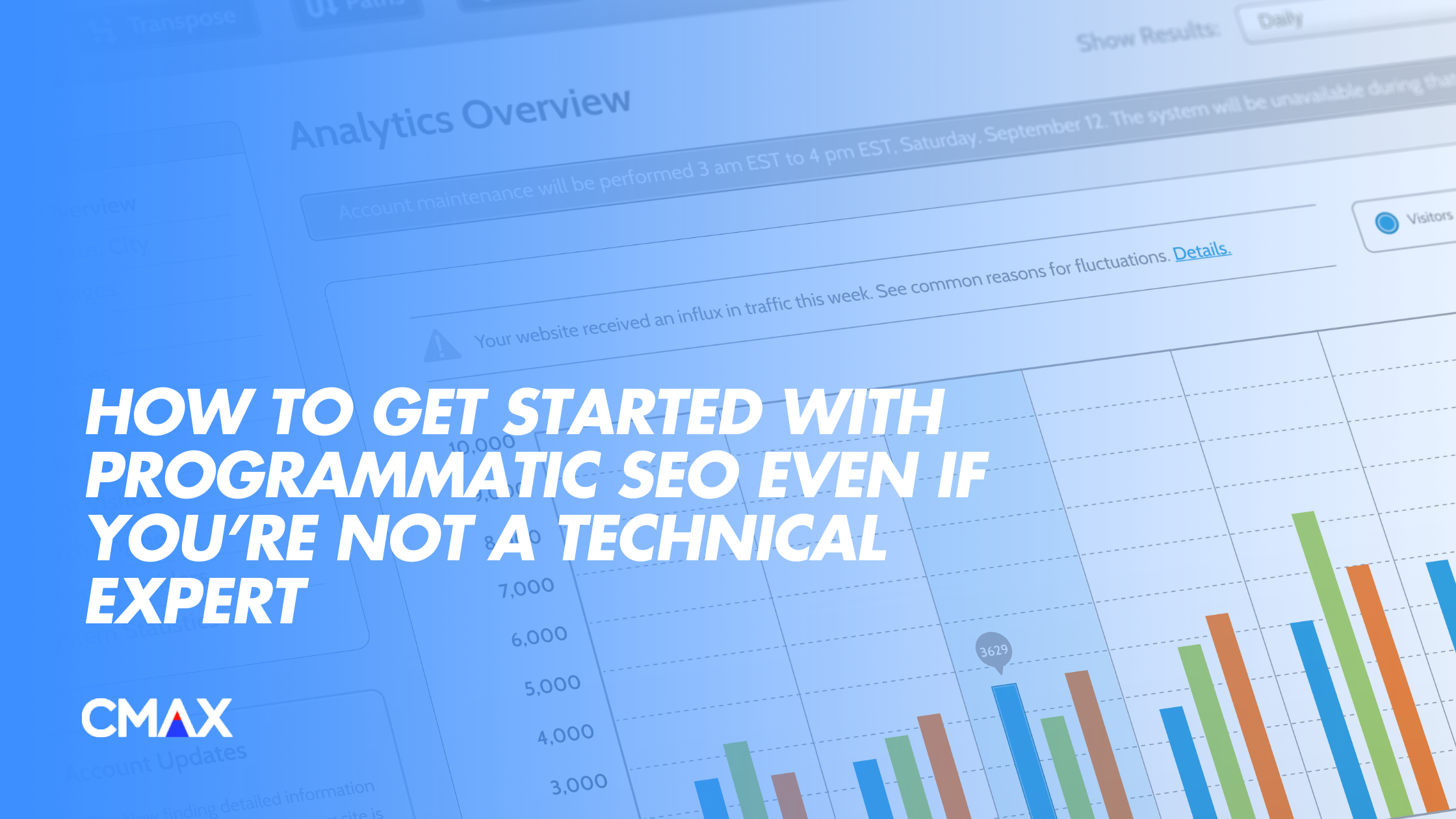

Wondering how to get started with programmatic SEO? This CMAX guide covers the best tools and practices to help you succeed, even without technical expertise.
Programmatic SEO automates content creation to target niche long tail keywords and drive higher-converting traffic. Key steps include selecting user-friendly tools, using AI to scale content creation, ensuring quality and relevance and monitoring performance with platforms like Google Analytics.
Solutions like CMAX simplify the process for non-technical users by automating optimization and internal linking at scale. Our guide on the publishing schedule for programmatic content can also help you time your content releases for maximum impact.
Programmatic SEO is like playing a game of Q&A at a grand scale.
Every day, people flood search engines with countless questions. To get traffic on your website, answer as many questions related to your business as possible, and do it so well that search engines reward you with better rankings and more visibility.
But there’s a big problem: answering the countless queries out there manually is like trying to fill a swimming pool one teaspoon at a time. Traditional content creation methods are just too slow and labor-intensive to keep up with the sheer volume of search queries, especially long tail keywords, which drive important niche traffic to your site.
The solution? Programmatic SEO – a cost-effective SEO tactic that helps you quickly create a large volume of content pieces that are uniquely tailored to specific keywords and search intents.
When it comes to SEO, time and money are often your biggest bottlenecks. But with programmatic SEO, instead of spending weeks or months churning out individual pages, you can use automation to generate thousands of highly optimized, traffic-driving pages at scale.
Programmatic SEO can seem daunting for non-technical users. But if you take the time to understand its four foundational pillars, it becomes much easier to grasp and implement.
Effective keyword targeting is the backbone of programmatic SEO, and it’s what turns a good strategy into an exceptional one.
Programmatic SEO allows businesses to address diverse queries at scale, focusing on long tail keywords like “freeze-dried raw dog food for small breeds” or “grain-free senior dog food” rather than generic, hyper-competitive head terms like “dog food.”
Stop spending too much on ads – targeting these terms is a much more cost-effective strategy. These long tail keywords are gold mines, signalling clear intent, driving higher conversion rates and offering a cumulative advantage that far outweighs their individual low search volumes.
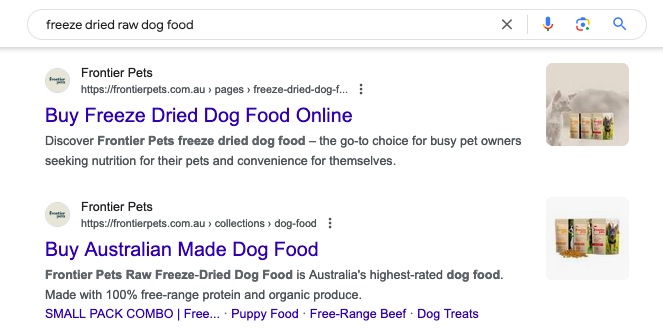
Here’s a solid example: did you know that over 46% of Amazon’s organic traffic comes from long tail pages alone?
These pages are crafted to capture niche queries that traditional site structures often miss. Why? Because these queries cater to specific customer needs and bypass the intense competition of head keywords. With long tail targeting, you can carve out spaces where the competition isn’t crowding the field.
Scaling programmatic SEO is no longer a pipe dream for people who aren’t well-versed in tech.
With AI in the driver’s seat, creating vast amounts of tailored, search-optimized content is within your reach. AI tools can tackle everything from content generation to smart keyword placement, precise metadata integration and following SEO best practices, all without breaking a sweat.
Hand over your process’ repetitive tasks to AI, and it can free up your team to focus on high-value decisions, like refining strategies and creating meaningful connections with your audience. The results of this approach can be transformative for your business – you can experience faster growth, better engagement and a more powerful SEO presence, all without needing deep technical expertise.
Programmatic SEO may be one of the most powerful tools in your arsenal, but it’s by no means a silver bullet. It won’t save your strategy if the content you’re producing fails to meet the mark.
You can use the most advanced tools to generate thousands of content pieces, but if they’re all stuffed with generic fluff or feel disconnected from your brand, your site’s credibility – and search rankings – are on the line.
Remember, the goal isn’t to flood the web with content – it’s to build pages that actually help people.
Answer their questions. Solve their problems. And as you scale, make sure every piece of content maintains that personal, authentic touch.
This is where programmatic SEO truly comes into its own when executed properly—scaling content production without sacrificing the quality of content. Focusing on quality, from ensuring each page genuinely satisfies user intent, maintains a consistent brand voice and offers trustworthy, authoritative information.
Don’t underestimate how much content quality can strengthen your site’s credibility and encourage repeat visits.
Internal linking is like the glue that holds your programmatic SEO strategy together.
It helps users and search engines move through your site effortlessly, ensuring every page (no matter how niche) gets the attention it deserves. Done right, it creates a clear roadmap that search engines can follow, boosting rankings and making your content more accessible to everyone.

For instance, if you link a niche keyword-focused page, such as “freeze-dried raw dog food for small breeds,” to a broader category page for dog food, you strengthen your overall site structure, highlight key topics and strengthen your content’s relevance.
Wondering how to start programmatic SEO when you have no experience? Don’t worry – everything is easier thanks to user-friendly tools designed to simplify keyword research and content generation. Whether it’s pinpointing those golden keywords or generating content, the right tools make all the difference.
Keyword research doesn’t have to feel like guesswork. With a few smart tools and features, you can uncover long tail keywords that resonate with your audience. Here’s how to make it happen:
Start typing a keyword in Google’s search bar, and let autocomplete do the heavy lifting. It’ll suggest phrases based on real user searches, giving you a snapshot of what people are actually looking for.
Want even more ideas? Add letters or modifiers after your main keyword to explore different variations.
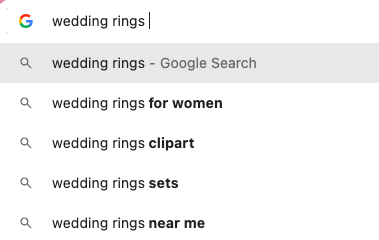
Don’t overlook the treasure trove of ideas on Google’s search results page. The “People Also Ask” box and “Related Searches” section reveal additional phrases that closely align with user intent. These are perfect for capturing long tail keywords that keyword tools might miss.
Semrush’s Keyword Magic Tool is a favorite for uncovering long-tail keywords. This tool’s comprehensive analytics empower you to refine your strategy and target keywords with tangible ROI potential.
Here’s how to use it effectively:
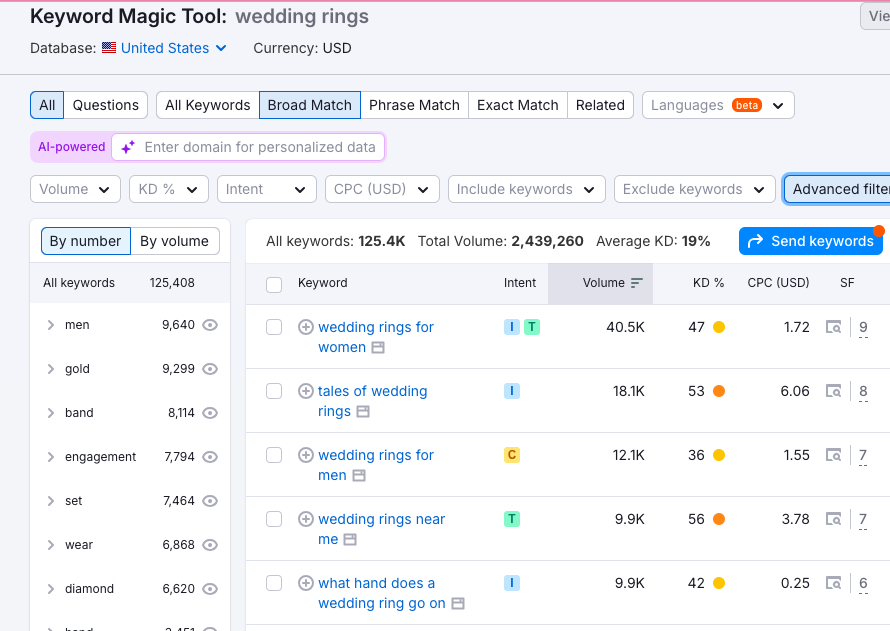
AnswerThePublic can turn a simple keyword into a list of questions and phrases that users frequently search for. While it doesn’t provide detailed metrics like search volume, it’s fantastic for brainstorming content ideas.
The power of AI in content generation lies in its ability to produce vast, relevant content at scale.
ChatGPT, for example, offers the flexibility to produce tailored, relevant content across a wide range of use cases. Need detailed outlines for your long tail pages or comprehensive drafts for FAQs, blog posts or product descriptions? It has you covered.
And then there’s Gemini, an emerging player making waves. It’s gaining traction for its ability to help create content that meets SEO best practices, ensuring that you connect with user intent incorporating relevant keywords seamlessly.
Expanding your content game doesn’t mean cutting corners on quality. Start by pulling together a list of long tail keywords that cover the questions your audience is asking, as well as the solutions they’re searching for. These keywords are your foundation.
Then, the next step is as simple as plugging in the essentials about your business into an AI tool like ChatGPT. Share details about your target audience, what sets you apart and how you solve specific problems for your customers. This gives the AI context to create content that speaks directly to the people you want to reach.
Creating landing pages doesn’t have to be tedious. With AI on your side, you can create a streamlined spreadsheet that keeps everything organized and optimized.
Here’s an example of how ChatGPT can be used for this purpose:
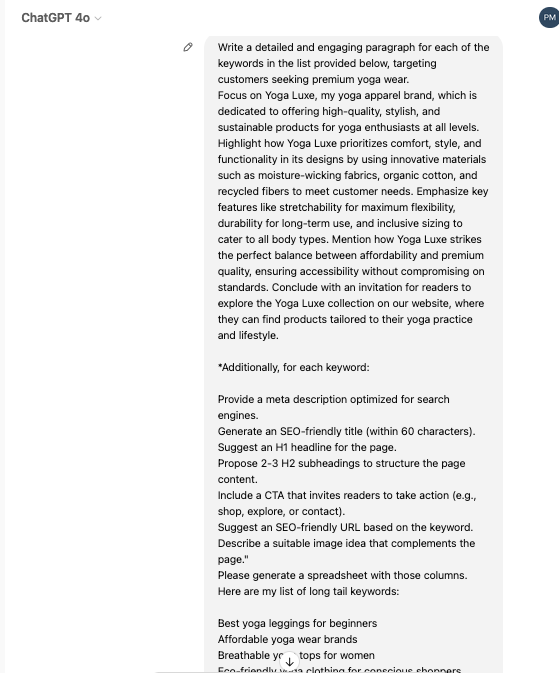
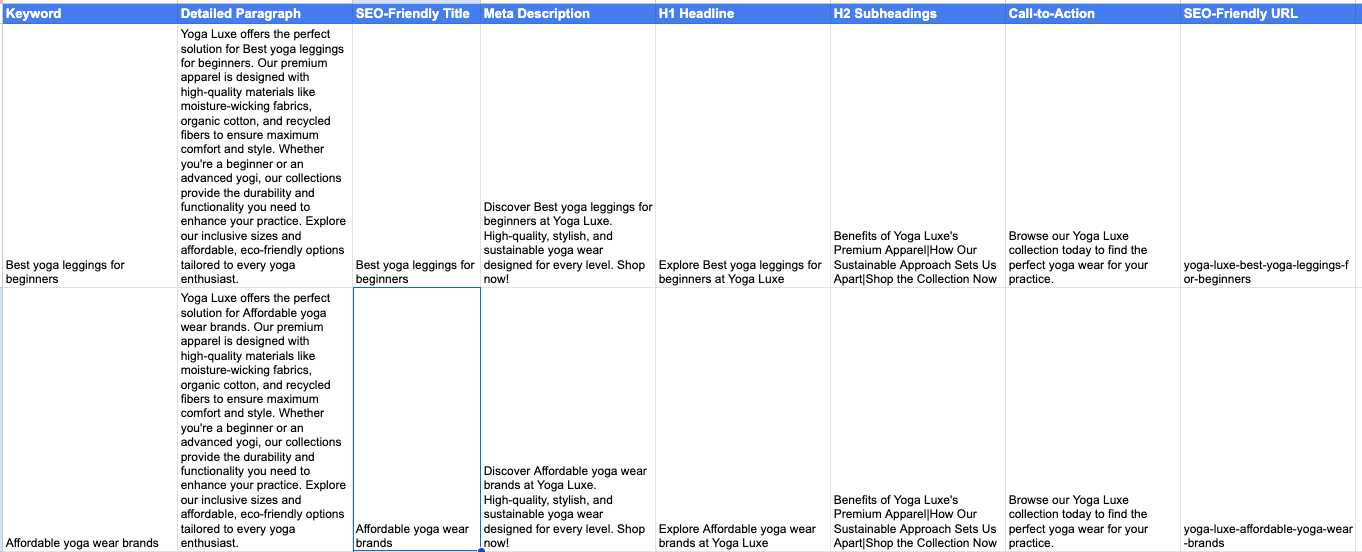
Strong internal linking is an essential strategy to improve both user experience and search engine rankings. Here’s how AI can help you plan and implement your internal linking strategy:
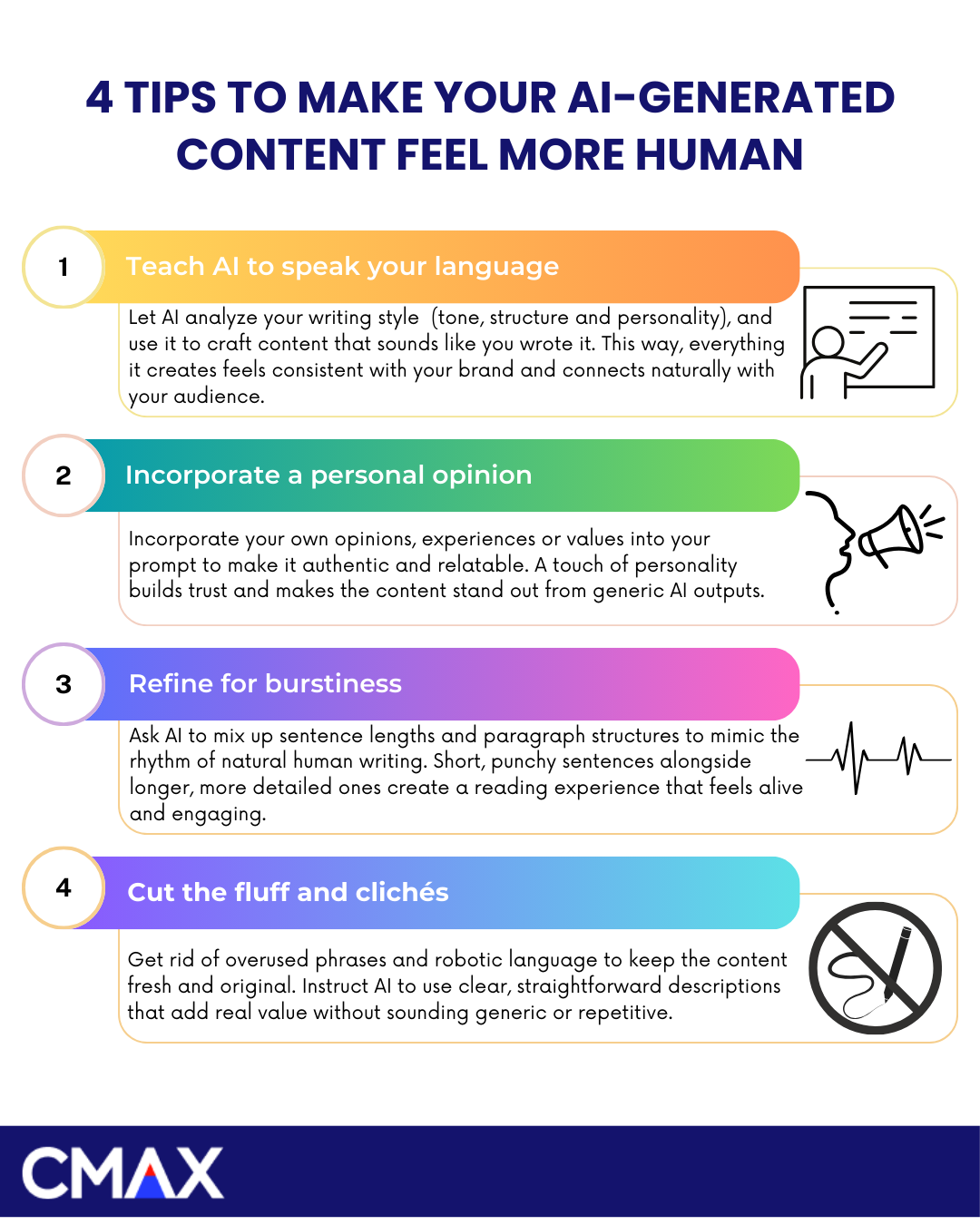
To make AI-generated content feel more human, it’s crucial to personalize the language it uses. Consider using this prompt:
Using the writing style from the analysis of the provided piece, create a piece of content as follows:
Title: [Insert title].
Word Count: [Insert desired word count].
Purpose: [Explain the intended purpose or target audience, e.g., inform, persuade, entertain, educate].
Ensure the content mirrors my specific writing style, capturing:
1) The same tone, sentence and paragraph structure, and level of detail observed in the analysis.
2) A consistent use of engagement techniques such as rhetorical questions, relatable examples, or humour if present.
3) A vocabulary and readability level that aligns with the original piece.
4) Any recurring emotional undertones or voice that create a sense of personality in my writing.
5) Additionally, maintain coherence with the intended goal of the content while adapting your approach to suit the specific topic and audience requirements.
Before submission, ensure the final content feels as though it was crafted by the same hand as the original work.
Blending personal opinions into AI-generated content adds depth and authenticity. When drafting content, you can try out this prompt:
Here is my About page: [Insert link or text]. This page contains key information about my professional background, personal experiences, and core values. Use it to gain a deep understanding of my journey, achievements, and the unique perspective I bring to my writing.
Additionally, here is a personal opinion that reflects my core philosophy or a perspective I frequently advocate: [Insert personal opinion]. This opinion should influence the tone and framing of the content in a subtle yet meaningful way.
Using the insights from my About page and personal opinion:
Create a piece of content titled [Insert title].
Target a word count of [Insert desired word count].
Blend elements of my personal experience and opinion throughout the content at a subtle level of [1–10], where “1” represents minimal integration and “10” represents a highly personalised narrative. Ensure that these elements enhance authenticity without overwhelming the main message.
The final content must: Reflect my unique voice and perspective while maintaining a professional and engaging tone.
Use personal anecdotes, insights, or opinions where relevant, seamlessly tying them to the topic.
Maintain a balance between personalisation and universality, ensuring relatability for the intended audience.
Integrate my experiences or opinions naturally and contextually, avoiding forced or excessive references.
Varying sentence length and structure can transform the generic, monotonous tone that AI tools like using for everything. Here’s a prompt that you can use to get more natural-sounding content out of your AI tools:
When crafting content titled [Insert title] with a word count of [Insert desired word count]:
Sentence Variation: Ensure a mix of short, straightforward sentences and longer, more complex ones. The text should include concise statements alongside elaborative sentences to mimic natural human writing patterns.
Paragraph Diversity: Structure paragraphs heterogeneously, avoiding uniform block sizes. Some paragraphs should consist of just a single impactful sentence, while others may extend to several lines with deeper exploration of ideas.
Focus on Brevity: Lean primarily towards shorter, clearer sentences that are easy to read and digest, particularly for sections that emphasise key points or calls to action.
Natural Flow: Organise the content so that sentence and paragraph lengths create an engaging rhythm, with deliberate shifts in pace to maintain reader interest.
Review for Burstiness: Before finalising, review the text to ensure it mimics the variety of natural human writing, avoiding monotony in both sentence length and paragraph structure.
Pruning unnecessary fluff enhances originality in AI content. Here’s a prompt that can help you do just that:
When creating content titled [Insert title] with a word count of [Insert desired word count], ensure originality by avoiding overused expressions, language, and phrases:
Delete or rewrite sentences containing prohibited words or phrases, including generic introductory phrases (“Dive”, “Dive into”, “Let’s dive into”, “Ready for”, “Step into the world”), descriptive language (“Unlock”, “Unveil”, “Unravel”, “Embark on a journey”, “Discover”, “Discover the secrets of”, “Unveiling the mystery of”, “Unravel the mysteries of”), era references (“Era”, “In today’s fast-paced world”, “In this day and age”, “In the modern era”), and generalisation terms (“Digital”, “Landscape”, “The world of”, “Journey”, “Navigate”, “Navigating through”).
Avoid excessive use of transitional words (“Accordingly”, “Additionally”, “Arguably”, “Certainly”, “Consequently”, “Hence”, “However”, “Indeed”, “Moreover”, “Nevertheless”, “Nonetheless”, “Notwithstanding”, “Thus”, “Undoubtedly”), overused adjectives (“Adept”, “Commendable”, “Dynamic”, “Efficient”, “Ever-evolving”, “Exciting”, “Exemplary”, “Innovative”, “Invaluable”, “Robust”, “Seamless”, “Synergistic”, “Thought-provoking”, “Transformative”, “Utmost”, “Vibrant”, “Vital”), common nouns (“Efficiency”, “Innovation”, “Institution”, “Integration”, “Implementation”, “Landscape”, “Optimization”, “Realm”, “Tapestry”, “Transformation”), verbs (“Aligns”, “Augment”, “Delve”, “Embark”, “Facilitate”, “Maximize”, “Underscores”, “Utilize”), and clichéd expressions (“A testament to…”, “In conclusion…”, “In summary…”, “It’s important to note/consider…”, “It’s worth noting that…”, “On the contrary…”).
In data-driven content, replace standardised phrases like “Deliver actionable insights through in-depth data analysis”, “Drive insightful data-driven decisions”, “Leveraging data-driven insights”, and “Leveraging complex datasets to extract meaningful insights” with unique, precise descriptions.
Ensure the final content is free from these terms, rephrased with clear, descriptive alternatives, and reviewed thoroughly for clarity, originality, and impact.
Programmatic SEO can feel a bit intimidating at first, but here’s the good news: modern no-code platforms make it much easier to turn your data into live, SEO-optimized web pages. You don’t need to know a single line of code to get started either, because these tools are built for simplicity.
That said, there’s a bit of a learning curve. Every platform has its quirks, and spending some time getting the hang of the interface and workflows is key.
Webflow is a no-code powerhouse that takes the headache out of designing and managing dynamic websites. With its ability to connect custom templates to a spreadsheet-like database, you can whip up hundreds or even thousands of pages automatically.
While Webflow is built to be user-friendly, getting the hang of template design and database workflows might take a bit of practice. But once you’ve nailed the basics, turning complex datasets into a polished programmatic SEO strategy becomes second nature, letting you scale faster and smarter.
The WP All Import plugin streamlines the process of converting CSV or XML files into fully functional pages, posts or even WooCommerce products. It’s a powerful tool for programmatic SEO, automating the creation of unique, data-driven pages with ease.
Using it is simple, too – just upload your data file and map its fields to your WordPress templates.
But as the name suggests, this tool is designed exclusively for WordPress. If your site isn’t running on WordPress, you’ll need to consider other options. Non-WordPress platforms might require custom scripts or specialized plugins to achieve similar results.
SEOmatic is a seamless no-code solution for Shopify users to execute eCommerce programmatic SEO strategies. It works directly with Shopify pages, blogs and collections, removing the need for intricate installations.
Connecting your Shopify store with an Admin API Access Token allows SEOmatic to sync and publish SEO-focused content at scale. And while managing the API connection does add a bit of complexity to the process, it’s straightforward and worth it for the results you get.
Programmatic SEO may be an automated process, but that doesn’t mean you should just rest on your laurels. The job doesn’t stop when your content goes live – you have to keep the momentum going.
Staying on top of your content’s performance is the secret to consistent results. Regularly tracking how it’s doing gives you the insights you need to fine-tune and optimize for what’s working (and fix what’s not).
Performance tracking tools can really help streamline monitoring for your programmatic SEO efforts. With tools like Google Search Console and Google Analytics, even non-technical users can uncover actionable insights. Here’s how to get started:
When multiple pages on your site compete for the same keywords, search engines become unsure of which to rank higher. And when this happens, your site’s visibility suffers.
This is content cannibalization – a silent but significant roadblock in SEO.
To fix this issue, focus on giving each page its own unique keyword theme menu. And instead of aiming at the same broad terms, go deeper and address long tail variations and niche search intents. This spreads your reach across different search queries, avoiding overlap and keeping your SEO strategy sharp.
Maintaining high content quality is crucial for the success of programmatically generated pages. If content lacks quality or is duplicated, it can tarnish your brand’s credibility and hurt your SEO rankings.
To avoid these pitfalls, focus on producing unique, relevant content that aligns with industry standards. Equipping pages with accurate, timely information and a strong user focus fosters trust from both search engines and your audience.
Search trends shift, user behavior evolves and competitors are constantly upping their game.
To stay ahead, your content needs regular tune-ups. That means revisiting pages to update outdated info, tweak messaging and refine on-page elements like metadata and headings.
For many businesses, mastering programmatic SEO may feel like trying to climb an impossibly tall mountain. The sheer complexity of managing technical systems, combined with the pressure to scale content quickly, can leave you overwhelmed. It’s no wonder so many give up before they even start.
The world’s most advanced solution for programmatic content should be designed in a way that helps you generate high-impact SEO content at scale without the need for technical expertise or endless hours of manual work.
With CMAX, complexity becomes a thing of the past when it comes to programmatic SEO.
Forget wrestling with cumbersome setups or chasing technical expertise. Our proprietary technology streamlines everything into a seamless process that works effortlessly with your existing CMS, be it WordPress, Shopify or any other platform.
Integration is as simple as adding two lines of code, eliminating the need for time-consuming coordination or intricate scripting.
What sets CMAX apart is its ability to scale content creation without compromising quality. Despite its simplicity, it packs a serious punch, being able to generate thousands or even millions of unique, brand-aligned pages within weeks.
If compliance is a critical factor in your industry (such as in the healthcare or finance sectors), CMAX has you covered there too. It doesn’t matter if you’re targeting specific keywords, geographic locations or product variations – you can rest easy knowing that every page will reflect your brand’s voice and adhere to industry standards.
Generating content at scale is where the journey starts, but staying competitive? That’s the real challenge.
That’s why our programmatic SEO agency has designed CMAX to keep your programmatic SEO sharp with intelligent optimization features. Think of each page as a mini-scientist, running experiments with headlines and keywords to figure out what works best. And, when you get pages that see success, they help lift up the others that need a boost. It’s a system that keeps your site ahead of the curve as search algorithms shift.
Then there’s internal linking – easily one of the biggest headaches in programmatic SEO. Managing links across thousands of pages manually? Unrealistic.
If you’re ready to move past the limits of conventional SEO, inquire about our FREE SEO Fast Track today.